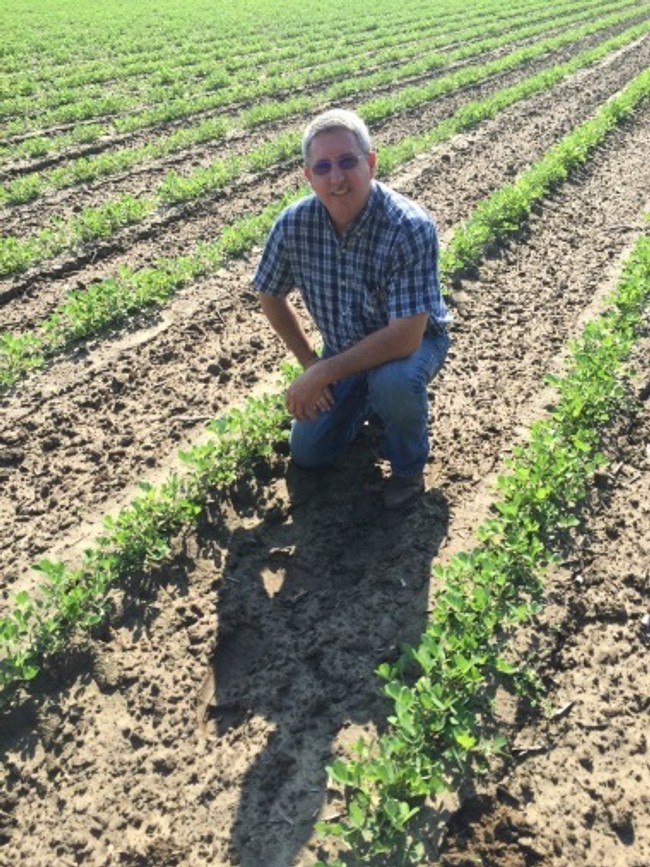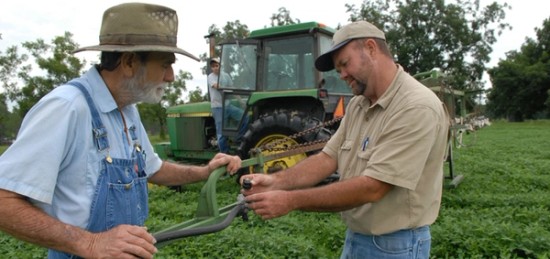For many farmers, life on the farm is a difficult yet rewarding job. There are several factors that have an impact on maintaining a successful farm, a few including diversification of crops, keeping up with the latest technology, facing environmental challenges and ultimately surviving in today’s economy. Hear what peanut farmers Gayle White from Oklahoma and Dan Ward from North Carolina said about peanut farming and how it supports the community and economy.

North Carolina peanut farmer Dan Ward

Oklahoma peanut farmers Gayle and Joe D. White
What are some of the crops you grow on your farm and how do you choose what crops to grow?
Gayle: We grow peanuts, cotton, wheat, milo, corn and sesame. Cotton and wheat have been our main crops because of the weather conditions here in Oklahoma. We chose to grow peanuts because they have been the most profitable crop we grow, but we’re limited to certain amount of acres of irrigation. We irrigate with a center pivot. That means we divide the field up into sections and rotate between peanuts, corn and cotton. If you continue to rotate, you’ll produce a better crop.
Dan: We grow corn, peanuts and soybeans on our farm in southeastern North Carolina. We consider ourselves peanut farmers first and the peanuts respond the best to a good rotation. We plant peanuts on our best land on different farms once every four years.
What are some of the challenges you face in the farming business?
Gayle: Weather and price are two huge factors. Right now, input costs are huge and continue to increase and commodity prices are dropping. It’s a challenging time. Commodity prices are depressed and margins are thin, so you really have to plan ahead.
Dan: We face challenges from weather, market prices, input prices and competition for good land. Irrigation is very expensive and our area sometimes suffers from too much water rather than too little. We are at the mercy of world markets, currency valuation, world trade agreements, and government policies that really do affect us at the farm level every year. North Carolina is heavily involved in sustainable energy and one form of renewable energy that has affected our farm are solar farms. The solar farm companies pay much higher rents on farmland than we can afford and they always want the best land with easiest access. My state now loses good farmland to solar farms more than housing and sometimes farmers are left with marginal land to grow crops.
What impact does farming have on supporting the community and economy?
Gayle: The entire economy is based on agriculture, because farmers have to feed the world. If farmers are doing well, they purchase equipment, employ people and donate to the community. When farmers are not doing well, we can’t afford to support the community. Agriculture and farming are the back bone of the world.
Dan: Agriculture is the number one industry in my town, county and state. It affects every home, church and business. We live in one of the poorest and most rural areas of the state. We have one of the largest counties as far as area but one of the smallest populations. We are basically 32,000 people and have maintained that population for 70 years. Forestry and farming utilize most of the land.
How has technology had an impact on farming?
Gayle: Technology has made tremendous improvements in agriculture. One technology we use is our GPS-guided equipment. It allows us to be extremely precise, allows for no-till farming, and it saves on water and fuel consumption.
Dan: We are using technology on our farm more and more every day. We use the sprayer equipment that turns itself on and off using satellites so that you don’t overspray or miss areas of the fields. We are using guidance on tractors so that every pass is parallel and straight. We use combine monitor programs to show us the actual yield on every part of the field. We use grid soil sampling on 2.5 acre grids to find out exactly what lime and nutrients we need to add to grow the crop. That information is downloaded to the fertilizer spreader so we never apply too much or miss any spots. This saves us a lot of money on fertilizer and lime and makes us better stewards of our land. The new technology on my phone and iPad also allows me to communicate with others, check markets and weather and monitor equipment from other farms.
